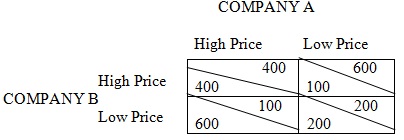Problem 1. When SRAC is declining, the firm experiences economies of scale.
Problem 2. A monopoly firm is a price taker.
Problem 3. Which of the following statements is NOT true?
- MC is a change of TC
- MC of labor is wage rate.
- A MC curve cuts through the minimum point of the AFC curve.
- AC = AFC + AVC
- When AC is greater than the MC, the firm produces more than the optimal level.
Problem 4. Which of the following statements is true about market structure?
- Whether it is a competitive firm, a monopolist, or a firm in monopolistic competition, a profit-max firm always produces at the level where MR = MC.
- A firm in monopolistic competition never experiences loss.
- A monopolistic firm charges the price that is the same as its AC.
- A firm in monopolistic competition's TR = P x Q and TC = MC x Q.
- None of above
Problem 5. Which of the following statements is NOT correct about cartel?
- OPEC is a cartel
- A group of firms form a monopoly
- Sherman Antitrust Act prohibits cartel
- Cartel arrangement may be tacit.
- A dominant firm sets price within a cartel and other firms follow and charge the same price.
Problem 6. Herfindahl-Hirschman index is a measure of market.
Problem 7. When two different types of consumers are separated in two markets, a profit-maximing firm may discriminate price if the two markets are completely separated and each market demand curve has a different.
Problem 8. May occur when products are used as the inputs for final products within a company. In the process of transferring products, the price set by a division transferring the intermediate products becomes the cost of another division that receives the products.
Problem 9. If P = $5, and AVC = $4, and TFC = $30,000, what is the break-even quantity?
Problem 10. Game Theory - Oligopoly Pricing Dilemman: Payoff Matrix Model

From the Payoff Matrix above, find the dominant strategy equilibrium. Explain your finding.
Problem 11: Havana Breeze restaurant is planning to build a new restaurant. The restaurant owner Miguel Sanchez estimates that the average number of customers per hour will be C1, C2, or C3 with respective probabilities of 0.5, 0.3, and 0.4. An architect has developed three building designs. The payoff table showing the profits
for the three designs is as follows:
Payoff Table
|
|
C1
|
C2
|
C3
|
|
Design A
|
$10,000
|
$15,000
|
$13,000
|
|
Design B
|
$9,000
|
$19,000
|
$11,000
|
|
Design C
|
$5,000
|
$15,000
|
$20,000
|
Estimate the expected profit for each design. Which design would Mr. Sanchez choose?
Problem 12. Explain the Baumol model that suggests revenue maximization as a firm's primary objective.